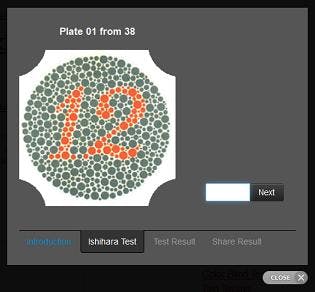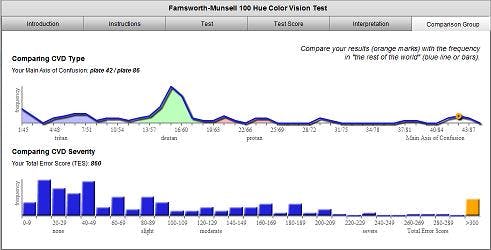Color Blindness
TEST YOUR REACTION TIME
Do you think you have fast reactions? Have you ever measured your reaction time? There’s an easy way to test reaction times using just a ruler.
Reaction time is the time taken for a person to respond to a stimulus. For example if you touch something very cold, there is a slight delay between you touching it and moving your hand away, because it takes time for the information to travel from your hand, to your brain where it is processed and then a response started. Many sports and activities require fast reactions!
Online 38 Plates Edition of Ishihara Color Blindness Test Released
I just released one of the oldest, definitely the most well known and definitely by far the most widely used color blindness test on earth: Ishihara 38 Plates CVD Test.
Unfortunately this test is not as good as one would think of:
- The original version detects just forms of red-green color blindness.
- The test is to selective: Even people with normal color vision may fail.
- It is based on a printed booklet. One has to be very careful with the handling.
- Often even eye doctors don’t know how to handle it correctly…
The original test is distributed as printed booklet and it started its tour around the world from Japan early last century. Dr. Shinobu Ishihara published the 38 plates as first version of his test, which is still known under the name Ishihara plates test. After the first test he also released a shorter 24 and even a quick 14 plate version of it.
The online version of this test is not as good as it could be. The scanning of the printed plates altered the colors and therefore the result is not as meanigful as with some other tests which you can find in my arrangement of color blindness tests.

When I take the test myself, I can see some numbers in some of the plates, but a lot of them are just a bunch of dots for me. If my children watch me doing so they always have to giggle, as they can see all the numbers and lines in all of the plates. Of course I know, I’m strongly red-blind and have quite some issues with colors. But in some plates I can’t see the slightes hint of a number! This makes me really think, as my kids easily spot all of them—even if my daughter just recently learned the numbers at all.
F-M 100 Hue Test: Compare Your Result with Others
A few days ago I released the F-M 100 Hue Color Vision Deficiency Test on Colblindor. Since then many people have taken the test which makes it possible to give you some added value on the test.
From today on you can also compare your result with “the rest of the world”. In the last tab of the test you will be able to see two diagrams: the first shows you the overall contribution of the different types. Your will be shown with an orange circle.

The second diagram below is all about the severity. Again your total error score is highlighted with an orange bar. This diagram shows you how others did in this test and if you are on the “better” or “not that good” side when it comes to see colors.
I hope you enjoy this added value and of course the whole F-M 100 Hue Test. If you have any questions or further suggestions, don’t hesitate to contact me.
Ishihara’s Test for Colour Deficiency: 38 Plates Edition
Dr Shinobu Ishihara introduced in 1917—almost 100 years ago—the most well known color blindness test. Each of his tests consists of a set of colored dotted plates, each of them showing either a number or a path. Since then this is the most widely used color vision deficiency test and still used by most optometrists and ophthalmologists all around the world.
There are other color blindness tests available, but none of them is as famous as the Ishihara plates. It is also well known, that even people with normal color vision sometimes struggle with this test. But nevertheless this plates are still in use in the absence of any better and still affordable color vision test.

